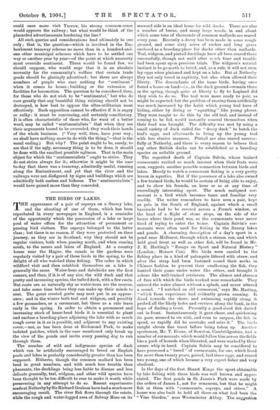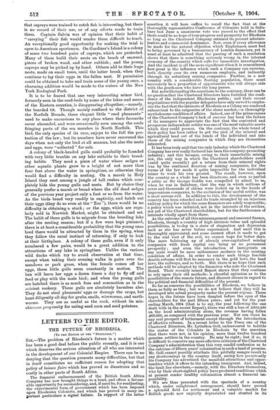T HE appearance of a pair of ospreys on a Surrey
lake, and the shooting of one of them, which has been reprobated in every newspaper in England, is a reminder of the opportunity which the possession of a lake or large pool of water offers for the attraction of permanent or passing bird visitors. The ospreys belonged to the latter class ; but there is no reason, if they were protected on their journey, as they are in Scotland, why they should not be regular visitors, both when passing north, and when coming south, to the meres and lakes of England. At a country house near the Hague, the canals in the gardens were regularly visited by a pair of these birds in the spring, to the delight of all who watched them fishing. The order in which wildfowl visit and then establish themselves on a lake is generally' the same. Water-hens and dabchicks are the first comers, and then, if it is of any size, the wild duck and that pretty and increasing species, the tufted duck, with a few coots. But coots are as naturally shy as water-hens are the reverse, and take some time before they can make up their minds to nest. The great crested grebe may next put in an appear- ance; and in the winter both teal and widgeon, and possibly a few goosanders, or a cormorant, but these as a rule leave early in the spring. In order to obtain a permanent and increasing stock of home-bred birds it is essential to plant and enclose a breeding-place adjoining the lake with as much rough cover in it as is possible, and adjacent to any existing cover,—not, as has been done at Richmond Park, to make isolated patches, which in the case mentioned only break up the view of the ponds and invite every passing dog to ran through them.
The number of wild and indigenous species of duck which can be artificially encouraged to breed on English pools and lakes is probably considerably greater than has been supposed. Hitherto, though the common mallard has been bred in great numbers, and with much less trouble than pheasants, the ducklings being less liable to disease and less delicate generally, teal, widgeon, and other wild species have been thought to be too difficult to rear to make it worth while persevering in any attempt to do so. Recent experiments made at Netherby by Sir Richard Graham have had a much more encouraging result. The river Esk flows through the estate, while the rough and water-logged area of Solway Moss on its
seaward side is an ideal home for wild ducks. There are also a number of burns, and many large woods, in and about which some tens of thousands of common mallards are reared every year. Recently a decoy has been made in some rough ground, and some sixty acres of rushes and long grass enclosed as a breeding-place for ducks other than mallards. Teal, widgeon, and pintail ducklings have all been reared there successfully, though not until after much time and trouble had been spent upon previous trials. The widgeon's natural instinct is to go north to breed, and, as a rule, it will not even lay eggs when pinioned and kept on a lake. But at Netherby they not only breed in captivity, but also when allowed their liberty. The descendants of the tame birds, having once found a home on land—i.e., in the duck ground—remain there in the spring, though quite at liberty to fly to Lapland did they wish to do so. The teal were more ready to pair, as might be expected, but the problem of rearing them artificially was much increased by the habit which young teal have of hiding, either by diving or "squatting" like young plover. They were taught to do this by the old teal, and instead of coming to be fed, would instantly conceal themselves when their food was brought. The difficulty was met by using a small variety of duck called the "decoy duck" to hatch the teal's eggs, and afterwards to bring up the young teal with less elusive manners. Pintail are also reared success- fully at Netherby, and there is every reason to believe that any other British ducks can be established as a breeding species on suitable ground.
The regretted death of Captain Salvin, whose trained cormorants excited so much interest when their feats were seen, suggests another possible connection between birds and lakes. Merely to watch a cormorant fishing is a very pretty lesson in aquatics. But if the possessor of a lake also owned a few trained birds, he would be certain of being able to enjoy, and to show his friends, an hour or so at any time of exceedingly interesting sport. The much maligned cor- morant is a bird which becomes tame and familiar very readily. The writer remembers to have seen a pair, kept as pets in the South of England, against which a small barricade had to be erected across a French window, at the head of a flight of stone steps, on the side of the house where their pond was, as the cormorants were never tired of trying to enter the house. Captain Salvin's cor- morants were often used for fishing in the Surrey lakes and ponds. A charming description of a day's sport in a pond near Midhurst, through which a stream ran, and which held good trout as well as other fish, will be found in Mr. J. E. Harting's "Essays on Sport and Natural History" (London : Horace Cox). His birds were carried to the fishing place in a kind of palanquin littered with straw, and after the strap had been fastened round their necks in Chinese fashion to prevent their swallowing the fish, they hunted their game under water like otters, and brought it ashore like well-trained retrievers. The silence and absence of fuss with which the birds worked were remarkable. They entered the water almost without a splash, and never uttered a sound. "I watched an old cormorant," says Mr. Harting, " which from experience had evidently grown cunning. It dived towards the shore, and swimming rapidly along, it probed all the likely holes and crevices along the bank, in the hope of finding a trout. Presently a good-sized fish darted out in front. Instantaneously it gave chase, and quickening its pace, seemed to vie with, and even to surpass, the fish in speed, so rapidly did he overtake and seize it." The birds caught eleven fine trout before being taken up. Another sportsman, Mr. T. Evans, of Sawston, Cambridgeshire, had a number of cormorants which would follow him across the fields like a pack of hounds when liberated, and were worked by their owner, whip in hand. Captain Salvin may be considered to have possessed a " breed " of cormorants, for one, which lived for more than twenty years, paired, laid three eggs, and reared two young, one of which became a very expert fisher and very obedient.
In the days of the first Stuart Kings the sport obtainable by lake fishing with these birds was well known and appre- ciated. The first ponds in St. James's Park were made by the orders of James L, not for ornament, but that he might fish in them with "cormorants, ospreys, and otters." A house was also built to hold all three on what had been the "Vine Garden," near Westminster Abbey. The suggestion
that ospreys were trained to catch fish is interesting, but there is no record of their use, or of any efforts made to train them. Captain Salvin was of opinion that their habit of " carrying " their fish would render them difficult to teach. An exceptionally good opportunity for making the trial is open to American sportsmen. On Gardiner's Island is a colony of some two hundred pairs of ospreys, which are protected. Many of them build their nests on the beach of seaweed, pieces of broken wood, and other rubbish ; and the young ospreys may be picked up by hand. Others add to their huge nests, made on small trees, until the latter break, when they continue to lay their eggs in the fallen nest If permission could be obtained to take and train some of the young ones, a charming addition would be made to the waters of the New York Zoological Park.
It is to be feared that one very interesting minor bird, formerly seen in the reed-beds by some of the lakes and meres of the Eastern counties, is disappearing altogether,—namely, the bearded tit. Though mainly confined to the district of the Norfolk Broads, these elegant little "reed pheasants" used to make excursions to any place where their favourite cover abounded, and were occasionally seen among the reeds fringing parts of the sea marshes in North Norfolk. This bird, the only species of its race, enjoys to the full the pro- tection of the law ; but its numbers have never recovered the days when not only the bird at all seasons, but also the nests and eggs, were " collected " for sale.
A colony of black-beaded gulls could probably be founded with very little trouble on any lake suitable to their breed- ing habits. They need a piece of water where sedges or other aquatic plants grow to a height of not more than four feet above the water in springtime, as otherwise they would find a difficulty in nesting. On a marsh in Holy Island they nest among a jungle of tall rushes which com- pletely hide the young gulls and nests. But by choice they generally prefer a marsh or broad where the old dead sedges of the previous year project only a foot or so from the water. As the birds breed very readily in captivity, and hatch out their eggs (they do so even at the " Zoo "), there would be no difficulty in obtaining a stock ; or the eggs, which are regu- larly sold in Norwich Market, might be obtained and set. The habit of these gulls is to migrate from the breeding lake after the nesting season; but if a few were kept pinioned, there is at least a considerable probability that the young ones bred there would be attracted by them in the spring, when they follow the usual instinct of returning, if only to look at their birthplace. A colony of these gulls, even if it only nurqbered a few pairs, would be a great addition to the attractions of any lake in springtime. Unlike the various wild ducks which try to avoid observation at that time, except when taking their evening walks in pairs over the meadows or park grass, when the female comes off her eggs, these little gulls seem constantly in motion. The hen will leave her eggs a dozen times a day to fly off and feed or play with the male bird; and when the young gulls are hatched there is as much fuss and commotion as in the noisiest rookery. These gulls are absolutely harmless also. They do not steal pheasants' eggs or damage the crops, but hunt diligently all day for grubs, snails, wireworms, and earth- worms. They are as useful as the rook, without its mis- chievous propensity for eating seed corn and seed potatoes.











































 Previous page
Previous page